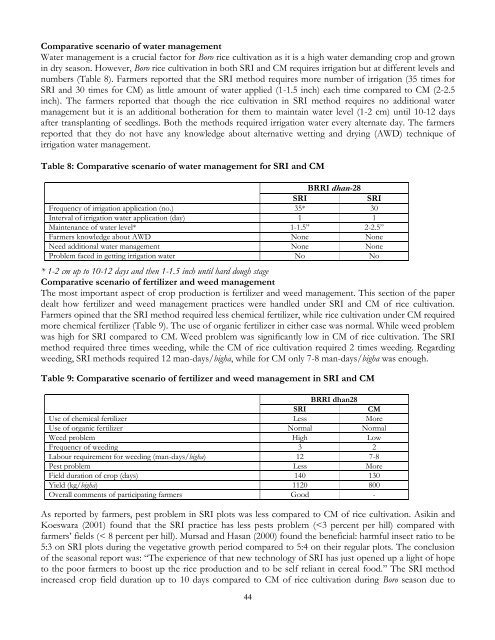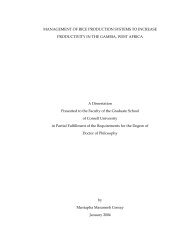Revised proceedings - The System of Rice Intensification - Cornell ...
Revised proceedings - The System of Rice Intensification - Cornell ...
Revised proceedings - The System of Rice Intensification - Cornell ...
You also want an ePaper? Increase the reach of your titles
YUMPU automatically turns print PDFs into web optimized ePapers that Google loves.
Comparative scenario <strong>of</strong> water management<br />
Water management is a crucial factor for Boro rice cultivation as it is a high water demanding crop and grown<br />
in dry season. However, Boro rice cultivation in both SRI and CM requires irrigation but at different levels and<br />
numbers (Table 8). Farmers reported that the SRI method requires more number <strong>of</strong> irrigation (35 times for<br />
SRI and 30 times for CM) as little amount <strong>of</strong> water applied (1-1.5 inch) each time compared to CM (2-2.5<br />
inch). <strong>The</strong> farmers reported that though the rice cultivation in SRI method requires no additional water<br />
management but it is an additional botheration for them to maintain water level (1-2 cm) until 10-12 days<br />
after transplanting <strong>of</strong> seedlings. Both the methods required irrigation water every alternate day. <strong>The</strong> farmers<br />
reported that they do not have any knowledge about alternative wetting and drying (AWD) technique <strong>of</strong><br />
irrigation water management.<br />
Table 8: Comparative scenario <strong>of</strong> water management for SRI and CM<br />
BRRI dhan-28<br />
SRI SRI<br />
Frequency <strong>of</strong> irrigation application (no.) 35* 30<br />
Interval <strong>of</strong> irrigation water application (day) 1 1<br />
Maintenance <strong>of</strong> water level* 1-1.5” 2-2.5”<br />
Farmers knowledge about AWD None None<br />
Need additional water management None None<br />
Problem faced in getting irrigation water No No<br />
* 1-2 cm up to 10-12 days and then 1-1.5 inch until hard dough stage<br />
Comparative scenario <strong>of</strong> fertilizer and weed management<br />
<strong>The</strong> most important aspect <strong>of</strong> crop production is fertilizer and weed management. This section <strong>of</strong> the paper<br />
dealt how fertilizer and weed management practices were handled under SRI and CM <strong>of</strong> rice cultivation.<br />
Farmers opined that the SRI method required less chemical fertilizer, while rice cultivation under CM required<br />
more chemical fertilizer (Table 9). <strong>The</strong> use <strong>of</strong> organic fertilizer in either case was normal. While weed problem<br />
was high for SRI compared to CM. Weed problem was significantly low in CM <strong>of</strong> rice cultivation. <strong>The</strong> SRI<br />
method required three times weeding, while the CM <strong>of</strong> rice cultivation required 2 times weeding. Regarding<br />
weeding, SRI methods required 12 man-days/bigha, while for CM only 7-8 man-days/bigha was enough.<br />
Table 9: Comparative scenario <strong>of</strong> fertilizer and weed management in SRI and CM<br />
BRRI dhan28<br />
SRI CM<br />
Use <strong>of</strong> chemical fertilizer Less More<br />
Use <strong>of</strong> organic fertilizer Normal Normal<br />
Weed problem High Low<br />
Frequency <strong>of</strong> weeding 3 2<br />
Labour requirement for weeding (man-days/bigha) 12 7-8<br />
Pest problem Less More<br />
Field duration <strong>of</strong> crop (days) 140 130<br />
Yield (kg/bigha) 1120 800<br />
Overall comments <strong>of</strong> participating farmers Good -<br />
As reported by farmers, pest problem in SRI plots was less compared to CM <strong>of</strong> rice cultivation. Asikin and<br />
Koeswara (2001) found that the SRI practice has less pests problem (

















